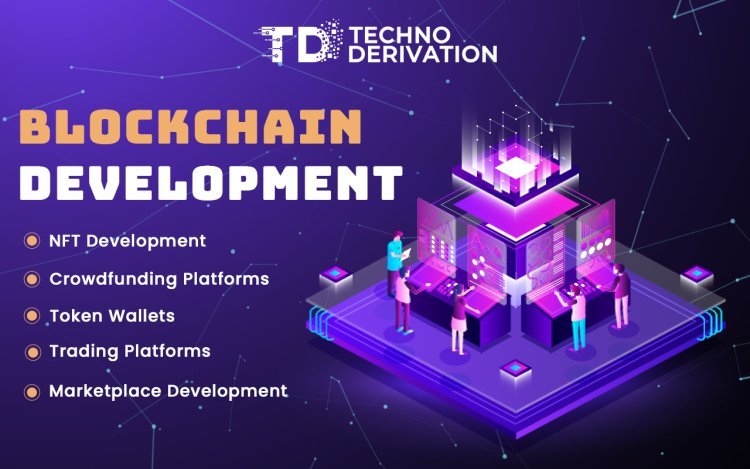Blockchain Application Development
Blockchain application development leverages decentralized, secure ledgers to enhance transparency and efficiency across various industries. This technology revolutionizes sectors such as finance, supply chain, and healthcare by providing immutable and tamper-proof transaction records.

Blockchain technology, once synonymous only with cryptocurrencies like Bitcoin, has evolved into a powerful tool with applications across various industries. The development of blockchain applications is rapidly transforming how businesses operate, offering enhanced security, transparency, and efficiency.
#### What is Blockchain?
Blockchain is a digital ledger that is decentralized and records transactions on numerous computers. This ensures that the recorded transactions cannot be altered retroactively, providing a secure and transparent way to track asset transfers. Each block in the blockchain contains a list of transactions and is linked to the previous block, forming a chain.
#### Key Features of Blockchain Technology
1. **Decentralization**: Unlike traditional databases managed by a single entity, blockchain is maintained by a network of nodes, ensuring no central point of control.
2. **Immutability**: After information is stored in a blockchain, it is extremely difficult to change, which guarantees the accuracy and reliability of the data.
3. **Transparency**: All transactions are visible to all participants, fostering trust and accountability.
4. **Security**: Advanced cryptographic techniques protect the data, making it highly secure against fraud and hacking.
#### Applications of Blockchain Technology
1. **Finance**: Beyond cryptocurrencies, blockchain is revolutionizing the finance industry through smart contracts, which automate and enforce agreements without the need for intermediaries. This reduces costs and increases transaction speed.
2. **Supply Chain Management**: Blockchain provides a transparent and tamper-proof record of product journeys from manufacturer to consumer, ensuring authenticity and reducing fraud.
3. **Healthcare**: Secure and immutable patient records on the blockchain enhance data sharing between healthcare providers while protecting patient privacy.
4. **Voting Systems**: Blockchain can create secure and transparent voting platforms, reducing the risk of election fraud and increasing public trust in electoral processes.
5. **Real Estate**: Blockchain simplifies property transactions by recording property rights and transfers on a tamper-proof ledger, reducing paperwork and increasing transaction speed.
#### Developing Blockchain Applications
Developing a blockchain application involves several steps:
1. **Identify the Use Case**: Determine if blockchain is the right solution. It's most effective for applications requiring secure, transparent, and tamper-proof data management.
2. **Choose the Right Blockchain Platform**: Platforms like Ethereum, Hyperledger, and Binance Smart Chain offer different features and capabilities. Choose the option that best fits the needs of your project.
3. **Design the Architecture**: Plan the application's architecture, including how data will be stored, managed, and accessed. Decide on the consensus mechanism (e.g., Proof of Work, Proof of Stake) and the type of blockchain (public, private, or consortium).
4. **Develop Smart Contracts**:Develop and evaluate smart contracts, which are automated agreements where the conditions are encoded in software and self-implementing. These are fundamental to blockchain applications, automating and securing transactions.
5. **Build the User Interface**: Develop a user-friendly interface for users to interact with the blockchain application.
6. **Test and Deploy**: Thoroughly test the application to identify and fix any issues. After testing is done, the application should be deployed on the selected blockchain network.
7. **Maintain and Upgrade**: Continuously monitor and upgrade the application to adapt to changing requirements and ensure security.
#### Challenges in Blockchain Development
Blockchain development encounters various obstacles, despite its promising potential:
- **Scalability**: Managing the growing amount of data on the blockchain can be challenging, affecting transaction speed and efficiency.
- **Regulation**: The regulatory landscape for blockchain technology is still evolving, with varying rules across different jurisdictions.
- **Interoperability**: Ensuring different blockchain systems can work together seamlessly is critical for broader adoption.
#### Conclusion
Blockchain application development is at the forefront of technological innovation, offering transformative solutions across multiple sectors. As the technology matures and overcomes current challenges, it promises to unlock new levels of efficiency, security, and transparency in the digital age. Developers and businesses that embrace blockchain technology today are likely to lead the way in the future's digital economy.
What's Your Reaction?











![Wireless Connectivity Software Market Size, Share | Statistics [2032]](https://handyclassified.com/uploads/images/202404/image_100x75_661f3be896033.jpg)



